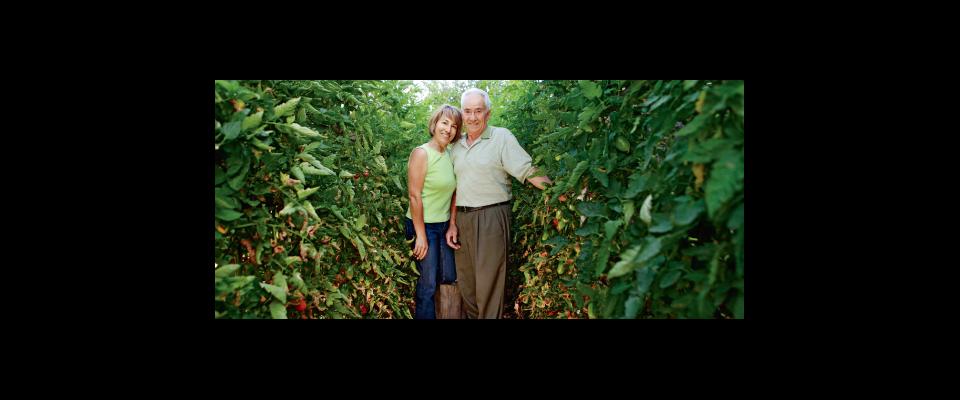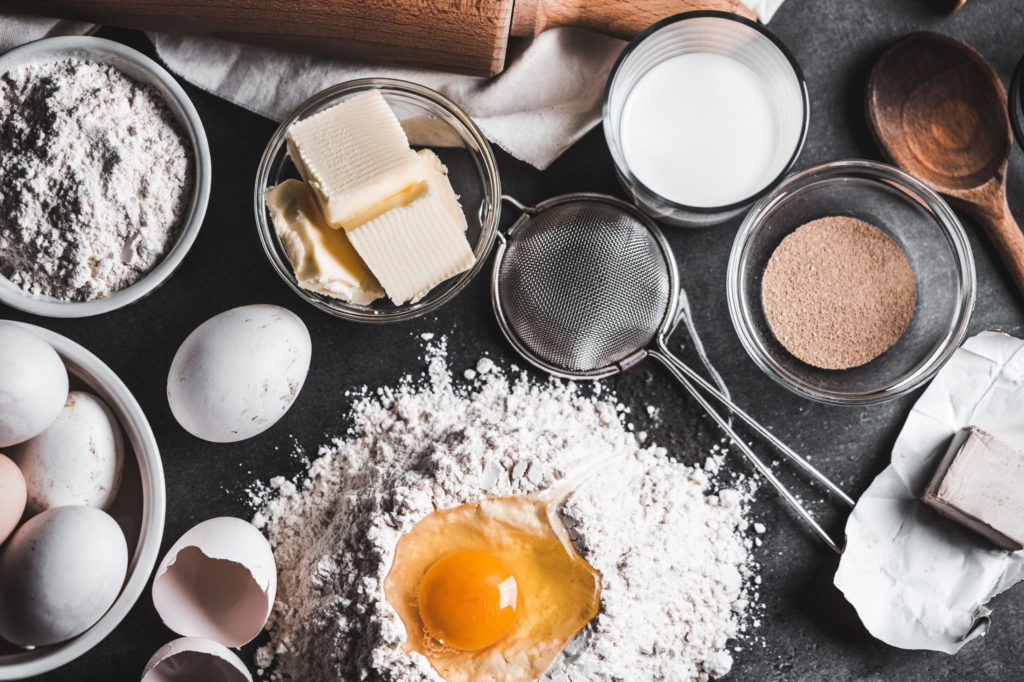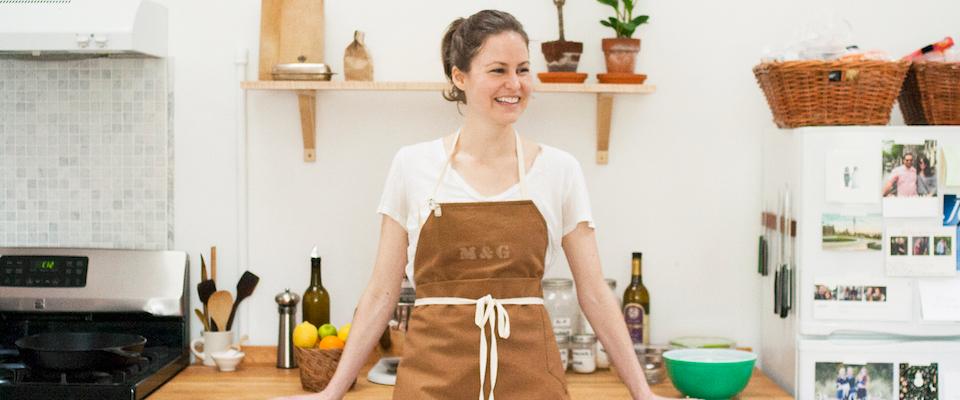A Cal alumna shares her family’s recipes with the world.
You could say that Rosetta Costantino was ahead of her time.
She was just two weeks shy of her 14th birthday when she arrived in the Bay Area with her parents, who were farmers lured by the prospect of a better life from an impoverished corner of southern Italy, called Calabria, that most people still don’t know.
Warned about the strange food in their new land—they’d heard stories that Californians ate “sponge bread,” later identified as Wonder bread—Vincenzo and Maria Dito came prepared. Back in Calabria, Vincenzo herded goats, made cheese, and grew all the family’s food, and he and Maria packed their bags full of seeds. They brought seeds for peperoni di senise, a sweet red pepper essential to the cooking in their hometown of Verbicaro, as well as seeds for San Marzano tomatoes, eggplant, hot peppers, and special varieties of zucchini. Maria carried a ball of bread starter in her purse, and uses it to this day for her crusty Calabrian-style loaves.
Settling in Oakland, Vincenzo went to work for Chiodo Candy, but still managed to plant a garden and build pens for goats and rabbits. Rosetta and her family soon were growing all of their fruits and vegetables, and sitting down to meals made in the Calabrian way: simple dishes prepared from ingredients fresh from the garden.
That kind of cooking is trendy now, but this was in 1974—before Chez Panisse, then in its third year, put such farm-to-table cuisine on the culinary map; before goat cheese and artisan bread became household staples; and before farmers’ markets started popping up on every corner.
“We couldn’t buy sweet Italian peppers or San Marzanos, or even broccoli rabe,” says Costantino ’83. “People didn’t know what they are.”
Now, at age 50—after graduating from Cal with a bachelor’s degree in chemical engineering, after a successful career in Silicon Valley, after marrying fellow Cal alum Lino Costantino ’81, and after raising two children—Costantino wants the world to know about her family’s traditions, about Calabria and its cooking.
Her new cookbook, My Calabria: Rustic Family Cooking from Italy’s Undiscovered South published in November 2010 by W.W. Norton & Co., introduces the region, her family and its recipes, along with advice about finding the right ingredients in local markets. A collaboration with Napa food writer Janet Fletcher, the book describes Calabria, the southernmost “toe” of Italy’s boot, as a verdant but rugged area, isolated from the rest of the country by its mountain ranges that abut the sea in places. The food is spicy and simple, the result of remarkable ingenuity in combining the few available ingredients. Seafood in Calabria abounded, but meats were scarce and consisted mainly of pork, goat, and rabbit, but rarely beef, which was prohibitively expensive to raise. Gardens and orchards carved out of the steep, rocky terrain had to provide all of the fruits, greens, wild herbs, vegetables, and olives; almost nothing came in from outside the area, and preserving was essential to filling bellies through the winter.
Costantino takes readers on a tour of the meticulous gardens her father maintains at his own house and hers, both atop a steep east-facing hillside looking across Highway 13 toward Montclair. Using traditional methods, like pruning with the phases of the moon, he raises hot and sweet peppers, tomatoes, favas, persimmons, and lemons—all the flavors of home, grown from seeds he gathers and saves each year, perpetuating the seed lines he brought from Calabria.
Her recipes show how to transform this bounty into sauces, pizzas, pickles, salumi (Italian cured meat), soups, and hearty dishes like polenta with borlotti beans and sausage. Included are instructions for making long coils of sausage and feather-light ricotta, and for fashioning homemade fusilli by wrapping pasta dough around knitting needles—everyday cooking in the Dito/Costantino family.
The book began as a personal mission, Costantino says. While scarcity and hardship drove many Calabrians to move to places like the Bay Area, they and their food remained invisible. According to Costantino, they didn’t open restaurants, and they wanted to blend in. “If I told people I was from Calabria, they’d say, ‘What country is that?'” she says. “It’s still not well known, and that’s one thing that propelled me to write the book.”
Though the life she describes may seem idyllic to today’s farmers’ market crowd, Costantino admits that she herself didn’t always prize her family’s traditions. As a teenager at Holy Names High School in Oakland, she quickly learned not to talk about the “weird foods” she ate at home, like pickled eggplant and tripe. She begged her mother to buy Thousand Island salad dressing at the supermarket because all her friends used it—the Ditos tried it once and never bought it again.
Weekends brought a different challenge. Costantino would drive her parents out into the country in search of vine-ripe tomatoes, olives begging to be picked, wild grapes, chicories, mustard greens, and fennel. (They refused to eat the pallid, flavorless produce they found in supermarkets.) Vincenzo and Maria didn’t speak much English, so when they found a promising field or orchard, they’d make their daughter ask permission to pick. Costantino remembers cringing and counting the minutes. “I thought we’d get arrested,” she says.
In college, Costantino fell in love with chemistry and with the international foods available in Berkeley, but she lived at home and ate at her mother’s table. When she graduated in 1983, Silicon Valley was in its infancy and she quickly landed a job in a Santa Clara startup that specialized in photomasking, part of the chip-making process. Immediately, she scoped out the best olive trees in the industrial parks around her for her parents to harvest.
Married and raising a family, Costantino says she would cook then-popular Tuscan food at home, for a time. Her parents, living close by, kept their garden and their traditions. They all loved Oakland and Berkeley because as the food culture developed, they could find good cheeses, produce, fish, and bread.
“They never changed. I blended in,” Costantino says. “It took me a while to feel that yes, we have weird food, and I want people to know. I don’t know if it’s because I was more mature, or have children and want to pass things on to them. I want people to know about this region of Italy. I’m proud of it.”
In 2001, Costantino scaled back her high-tech work. Her daughter was 10, her son 6, and she wanted to focus more on them. She started offering classes in Calabrian cooking in 2004 and began writing her book.
In her classes, she discovered a hunger for the kind of cooking she’d grown up with—from budding young cooks newly interested in home cooking and fresh, local foods as well as from second-, third-, and fourth-generation Calabrians who wanted to reconnect with their culture. “I really started appreciating what I had,” she says. “I always felt we didn’t have the luxuries—then I grew up and realized how rich we were in the things people want.”
Throughout her career, despite the demands of her management position, she says, “Cooking stayed with me. Both my grandmothers were wonderful cooks and my mom also, and they all allowed me to be in the kitchen. That’s how I learned—by watching.”
Her mother has never used recipes, but Costantino says her own engineering background made it easy for her to write them for the book. “It’s like detailing a process,” she says. “Do this. Mix it with this. Stir it with that. Cook it.”
The book took her five years to produce. At times she had to fend off suggestions that she embellish her recipes with ingredients popular with American cooks. But Costantino stuck to her guns—and to what she’d learned, handed down through the generations, brought all the way from Calabria to California, and increasingly a way of life in the Bay Area.
If you use the right ingredients, and the best recipe, “you don’t need to put a lot of things in.”






















